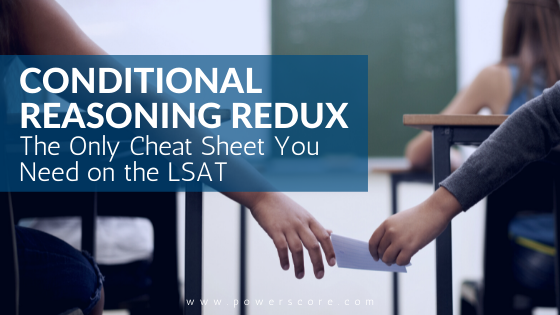First, a disclaimer. You cannot have a cheat sheet when taking the LSAT. Don’t even think about it. But, if you follow the advice below, you wouldn’t need to. This cheat sheet is for those of you who struggle with the myriad of ways in which the LSAT conveys conditional relationships. We feel your pain! It sucks encountering 20 different ways of saying the same thing. Then again, that’s what makes natural language different from coding.
A Word of Caution
Before we get into the specifics of the cheat sheet, head this warning. If you tend to see conditional reasoning everywhere, you’ve probably gone too far. Check out this blog post, and please resist the urge to diagram every other argument on the test. Diagram only when you believe it will help you understand what the author is saying.
For example, maybe you only diagram stimuli containing more than two conditional relationships that either need to be connected in a chain (usually for Must Be True or a Parallel Reasoning questions), or cannot be connected because of a missing link (which needs to be deductively determined in order to answer an Assumption or Justify question).
Conditional Reasoning Cheat Sheet
Print this out and pin it above your desk or add it to your study bible. You’ll be glad you did.
| A → B (NOT B → NOT A) | A → NOT B (B → NOT A) | NOT A → B (NOT B → A) | A ↔ NOT B (B ↔ NOT A) | A ↔ B (NOT B ↔ NOT A) |
| If A, then B If not B, then not A All As are Bs A only if B Not A, unless B Not A, until B Only B can be A The only way to do A is to do B A depends on B Cannot have A without B None but B are A None except B are A Not until I do B can I do A | If A, then not B If B, then not A No A are B No B are A Cannot have both A and B A depends on not B B depends on not A A only if not B B only if not A At most one of A or B is selected At least one of A or B is not be selected | If not A, then B If not B, then A Without A, we must have B Without B, we must have A At least one of A or B is selected At most one of A or B is not selected Either A or B is selected
| Either A or B, but not both, is selected All but A are B All but B are A All except B are A All but A are B All but B are A A if and only if not B B if and only if not A Either A is selected without B, or else B is selected without A Either A is selected and B is not selected, or else B is selected and A is not selected | If A then B, and if B then A A and B are interdependent All A are Bs and all B are A Cannot have A without B, and cannot have B without A Either A and B are both selected, or else neither A nor B is selected |


Leave a Reply